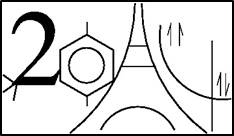Graphene is the prototype of two-dimensional materials, but is not the only one. SiO2films of few nanometers thickness grown on Si have been the basis of the microelectronics revolution in the second half of last century. In general, ultrathin oxide films grown on a metal, also called two-dimensional oxides, have a wide range of applications [1]. Oxides at the nanoscale may exhibit specific surface morphology, physical properties, chemical reactivity, thus providing new opportunities for the design of innovative materials. Here we will address in particular the role of two-dimensional oxides for heterogeneous catalysis. Theory has a very important role in this field and, in combination with experiments, can answer several important questions like: are the electronic properties of an oxide film of just a few atomic layers similar to those of the corresponding crystalline phases? How thick an oxide film has be to recover typical bulk properties? How important is the formation of a metal/oxide interface for the surface properties? What is the role of the strain in the supported layer? These and other related questions will be addressed in this talk by discussing transport phenomena across two-dimensional oxides (charging effects), the structural flexibility of oxide ultrathin films, nanoporosity, and in general the possibility to design nano-structured oxides with new properties and functionalities [2,3].
[1] G. Pacchioni, “Two-dimensional oxides: multifunctional materials for advanced technologies”, Chemistry a European Journal, 18, 10144-10158 (2012).
[2] L. Giordano, G. Pacchioni, Accounts of Chemical Research, “Oxide films at the nanoscale: new structures, new functions, and new materials”, 44, 1244-1252 (2011).
[3] G. Pacchioni, H. J. Freund, “Electron transfer at oxide surfaces. The MgO paradigm: from defects to ultrathin films”, Chemical Reviews, 113, 4035-4072 (2013).

 PDF version
PDF version
